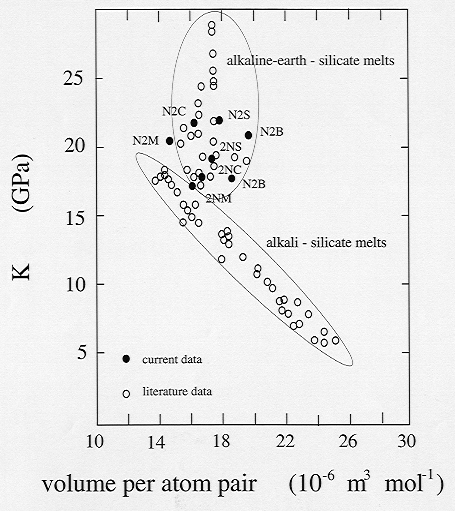

The majority of silicate melt compositions have a relaxed bulk modulus in the range 5 to 20 GPa at a pressure of 105 Pa. The alkaline-Earth bearing melts have much higher bulk moduli, from 20-30 GPa. That is, they are not as compressible as the alkali-silicate (alkaline-Earth poor) melts studied to date. Furthermore, it has been shown previously that the bulk moduli of XO-bearing (X = Mg, Ca, Sr, Ba) silicate melts do not follow the simple empirical trends observed as a function of density for most silicate melts and the alkaline-Earth bearing silicate melts also do not follow the "Law of Corresponding States" which relates the bulk modulus to the volume-per-atom of the melt (see Fig. 3.7-4). Given the large effect alkaline-Earth oxides have on decreasing the compressibility of silicate melts (and therefore reducing the density increase with increasing pressure), and the ubiquitous nature of these components in natural magmatic systems, their equations of state need to be investigated in more detail. The effect of composition and temperature on the compressibility of melts in the XO-Na2O-SiO2 system has been investigated. The relaxed bulk moduli were measured using ultrasonic interferometric methods at frequencies of 3, 5 and 7 MHz. The measurements were carried out in the temperature range of 1000 - 1575 °C. For these melts, the bulk modulus increases with increasing mole fraction of XO.
The velocities of longitudinal waves propagating through these melts were determined at ultrasonic frequencies using a furnace and twin-molybdenum buffer-rod apparatus. There is a constant flow of forming gas (95 % N2 - 5 % H2) across the molybdenum furnace elements and the molybdenum crucible and buffer-rods. Chrome-gold, coaxially-plated, 2 MHz quartz X-cut compressional wave transducers were used at the first, third and fifth harmonic frequency. The interferometric measurements are performed in the reflection mode, with the transducer acting as both sender and receiver. Pulsed sinusoidal signals of 80 msec duration were propagated through the melt and the change in amplitude of the returned signal was monitored as the upper buffer-rod was moved.
The calculated bulk moduli, K = ρ v2,
for density ρ and velocity v, have a standard
error of less than 1 %. For all of these melts no frequency dependence
of the measured velocities was observed. This indicates that the viscosities
of these melts are low enough in the investigated temperature ranges, that
the relaxed bulk moduli of the melts are determined using ultrasonic techniques
in the 3-7 MHz range. In the relaxed regime for each melt composition,
the relaxed longitudinal modulus (M) is equal to the relaxed bulk modulus
of the melt as the shear modulus (G) is zero. The compressibility ß
of the melt is the inverse of the bulk modulus, i.e., K = ß-1
= -V-1.∂ P/∂
V, and the bulk modulus describes the volume (V) as a function of pressure
(P).
 |
|
|
Figure 3.7-4 illustrates bulk modulus as a function of volume-per-atom-pair for literature data at different temperatures, and for the present melt compositions at 1500 °C. All of the present melts plot in the bulk modulus - volume field of the alkaline-Earth rich melts. It can be seen for the present MgO-bearing melts that the bulk modulus decreases with increasing volume per atom pair. This is similar to the behaviour of most alkali-silicate melts in which volume-per-atom increases while the bulk modulus decreases. For the SrO- and BaO-bearing melts, however, the volume per atom pair decreases as the bulk modulus decreases. This would suggest that there are large structural changes occurring in these melts as the composition is varied.
The compressibilities of the present XO-Na2O-SiO2 melts and XO-SiO2 melts in general are lower than those of alkali-rich silicate melts. This difference in compressibility between alkaline Earth-rich and alkali-rich silicate melts needs to be taken into account in models of the compressibility of melts in the Earth's crust, the density of melts in magma chambers and the rising or sinking of magmas at high pressure.

Tel: +49-(0) 921 55 3700 / 3766, Fax: +49-(0) 921 55 3769, E-mail: bayerisches.geoinstitut(at)uni-bayreuth.de
 Previous page
Previous page